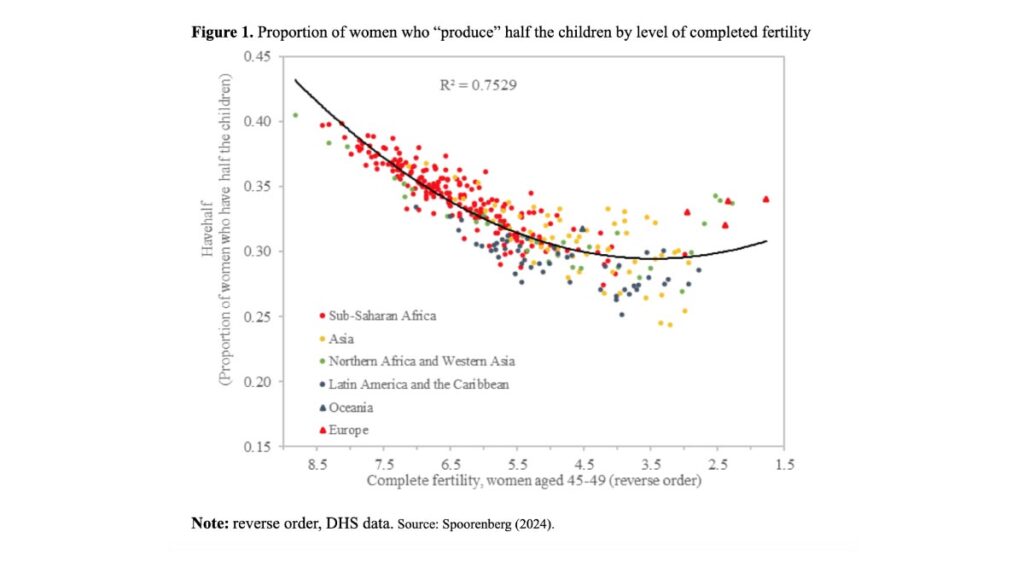Thomas Spoorenberg* updates earlier studies on the increased concentration of reproduction as fertility declines, a trend that is now also apparent in developing countries.
When discussing population trends, demographers often still focus on average measures such as the total fertility rate (TFR) or the average number of children ever born per woman. But averages can obscure critical differences within populations, so looking beyond questions such as “how many children are born?” provides a more nuanced picture of population dynamics. Among the dimensions rarely investigated is the question of “who bears the children” within a population. Considering the concentration of reproduction among women within a population, or the proportion of women who contribute to childbearing, advances our understanding of demographic change and its far-reaching implications.
Why look beyond fertility averages?
Let’s consider two hypothetical populations, each with an average of two children per woman. In one, half the women remain childless while the other half have four children each. In the other, every woman has two children. Although TFRs of these populations are identical, the distribution of reproduction differs greatly. In the first, reproduction is highly concentrated: half of the women account for all of the children. Conversely, in the second, reproduction is equally distributed. These differences affect family structures, future kin networks, and societal dynamics. For example, children in the first population grow up with more siblings, while parents in the second population have fewer children to support them in old age. Societal impacts also include unequal child-rearing burdens, healthcare risks, and shifts in demand for housing, education, and goods.
One way of studying changes in how reproduction is distributed among women within a population is to look at “have” statistics, especially the “have-half” statistic, i.e. the minimum proportion of women who give birth to half of the children in a population (Vaupel and Goodwin 1987). Other measures like the Gini coefficient or “half-have” (the proportion of children born to half the women) can also be used, yielding virtually the same results, as they correlate strongly with the have-half measure.
A couple of studies have examined the concentration of reproduction in developed countries, showing that the lower the fertility, the smaller the minimum proportion of women who contribute to bearing half of the children (Lutz 1989; Skolnikov et al. 2007). Evidence from developing countries has remained more limited, mainly due to data limitations: long time series are still scarce and/or geographic coverage is partial (Lutz 1989; Giroux et al. 2008). A recent study re-examined the shifts in the concentration of reproduction during the fertility transition by extending the observation period by several decades, considering a larger range of fertility levels, and expanding the geographic coverage to include more countries from all regions of the world (Spoorenberg 2024).
Patterns in developing countries
Data on completed fertility collected in 350 sample surveys from 87 developing countries, revealed a consistent pattern of change across four decades in the concentration of reproduction. Figure 1 shows that the proportion of women who “produce” half of the children—the “have-half”—follows a general pattern of decline by level of completed fertility (Figure 1). At higher fertility levels (e.g., eight children per woman), a larger proportion of women contributes to “producing” half of the children than at lower fertility levels. In other words, the lower the fertility level, the more concentrated the reproduction. The decline in fertility also reduces high-order births, shifting the distribution towards smaller family sizes, and is accompanied by an increase in childlessness.

Figure 1 also distinguishes data points by region. Variations across countries and regions are observed, depending on where countries stand in their path towards lower fertility and their specific sociocultural contexts. In general, sub-Saharan African countries cluster around completed fertility levels of at least 6 children per woman, and countries in Europe and Western Asia at levels below 3. Countries in other regions are spread between these two extremes.
Countries are also clustered more closely around the global trend at higher levels of completed fertility than at lower levels, indicating that the minimum proportion of women having half of the children is more homogenous across countries when fertility is high, as for instance in sub-Saharan Africa. In contrast, Asian countries present the largest variations in their “have-half” statistics. These patterns suggest that, behind the global trend of a higher concentration of reproduction associated with lower fertility levels, there are multiple paths towards lower fertility.
Implications for policy and society
Understanding the concentration of reproduction adds nuance to how we interpret fertility transitions. Unequal distribution of childbearing can exacerbate social inequalities, as fewer women bear the physical, emotional, and financial costs of raising children. It also affects intergenerational dynamics, such as the availability of future kin support for older adults. Policymakers could use this information to design more equitable social policies, such as support systems for child-rearing or targeted investments in maternal health.
The experience from developing countries complements earlier studies from developed regions, showing that the relationship between fertility levels and reproductive concentration is a global phenomenon with local variations.
Looking at the concentration of reproduction offers a valuable lens to explore demographic changes and their broader implications. Focusing on who bears children—not just how many are born—underscores the importance of diversity in understanding population dynamics. As fertility continues to decline worldwide, paying attention to reproductive concentration will be crucial for anticipating social, economic, and demographic challenges.
References
Giroux, S.C., P.M. Eloundou-Enyegue, D.T. Lichter (2008), “Reproductive inequality in sub-Saharan Africa: Differentials versus concentration,” Studies in Family Planning 39(3): 187-198. https://doi.org/10.1111/j.1728-4465.2008.166.x
Lutz, W. (1989), Distributional Aspects of Human Fertility. A Global Comparative Study. London: Academic Press
Shkolnikov, V.M., E.M. Andreev, R. Houle, J.W. Vaupel (2007), “The concentration of reproduction in cohorts of women in Europe and the United States,” Population and Development Review 33(1): 67-100. https://doi.org/10.1111/j.1728-4457.2007.00159.x
Spoorenberg, T. (2024), “The concentration of reproduction during the fertility transition in developing countries,” Population and Development Review 50(4): 1353–1368, https://doi.org/10.1111/padr.12659
Vaupel, J.W., D.G. Goodwin (1987), “The concentration of reproduction among US women, 1917-80,” Population and Development Review 13(4): 723-730. https://doi.org/10.2307/1973030
*The views expressed in this paper are those of the author and do not necessarily reflect those of the United Nations


